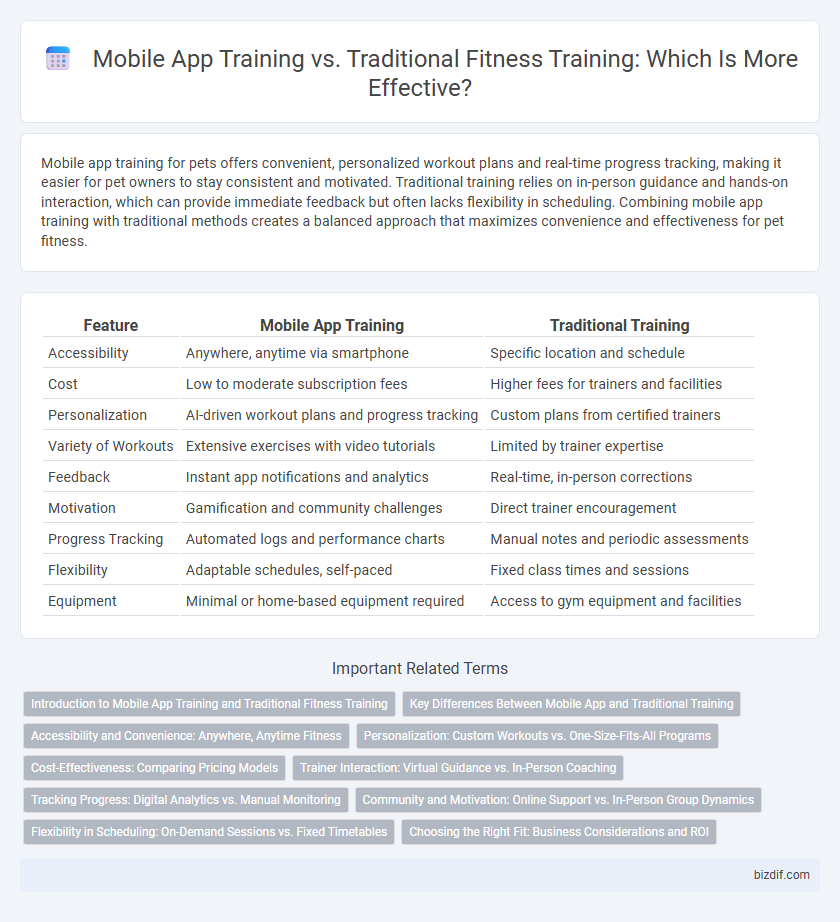Mobile app training for pets offers convenient, personalized workout plans and real-time progress tracking, making it easier for pet owners to stay consistent and motivated. Traditional training relies on in-person guidance and hands-on interaction, which can provide immediate feedback but often lacks flexibility in scheduling. Combining mobile app training with traditional methods creates a balanced approach that maximizes convenience and effectiveness for pet fitness.
Table of Comparison
| Feature | Mobile App Training | Traditional Training |
|---|---|---|
| Accessibility | Anywhere, anytime via smartphone | Specific location and schedule |
| Cost | Low to moderate subscription fees | Higher fees for trainers and facilities |
| Personalization | AI-driven workout plans and progress tracking | Custom plans from certified trainers |
| Variety of Workouts | Extensive exercises with video tutorials | Limited by trainer expertise |
| Feedback | Instant app notifications and analytics | Real-time, in-person corrections |
| Motivation | Gamification and community challenges | Direct trainer encouragement |
| Progress Tracking | Automated logs and performance charts | Manual notes and periodic assessments |
| Flexibility | Adaptable schedules, self-paced | Fixed class times and sessions |
| Equipment | Minimal or home-based equipment required | Access to gym equipment and facilities |
Introduction to Mobile App Training and Traditional Fitness Training
Mobile app training offers personalized workout plans, real-time progress tracking, and on-demand access to diverse exercise routines, making fitness training more flexible and accessible. Traditional fitness training relies on in-person sessions with certified trainers, providing hands-on guidance, immediate feedback, and motivation through direct social interaction. Both methods aim to improve physical health but differ in convenience, customization, and user experience.
Key Differences Between Mobile App and Traditional Training
Mobile app training offers personalized workout plans, real-time tracking, and on-demand accessibility, contrasting with traditional training's reliance on in-person guidance and fixed schedules. Mobile apps utilize AI and data analytics to tailor exercises, whereas traditional methods depend heavily on trainer expertise and manual progress monitoring. The convenience of mobile platforms enables broader reach and flexible engagement, while traditional training emphasizes hands-on correction and social interaction.
Accessibility and Convenience: Anywhere, Anytime Fitness
Mobile app training offers unparalleled accessibility, enabling users to engage in personalized workouts anytime and anywhere, eliminating the need for gym visits. Traditional training often requires scheduled sessions at specific locations, limiting flexibility for users with busy or unpredictable lifestyles. Mobile fitness apps integrate features like progress tracking and customizable routines, enhancing convenience and sustained motivation beyond the constraints of traditional gym environments.
Personalization: Custom Workouts vs. One-Size-Fits-All Programs
Mobile app training offers highly personalized workouts tailored to individual fitness levels, goals, and preferences through data-driven algorithms and progress tracking. Traditional training often relies on standardized, one-size-fits-all programs that may not address specific needs or adapt quickly to user progress. Personalized mobile app workouts enhance motivation and effectiveness by dynamically adjusting routines based on real-time feedback and performance metrics.
Cost-Effectiveness: Comparing Pricing Models
Mobile app training offers significantly lower upfront costs and flexible subscription plans compared to traditional training's often higher hourly rates and gym membership fees. Users can access personalized workout programs and progress tracking without expensive equipment or appointments, maximizing value for budget-conscious fitness enthusiasts. Cost-effectiveness is enhanced through scalable digital features and the elimination of commuting and facility expenses, making mobile apps a more economical choice for consistent fitness training.
Trainer Interaction: Virtual Guidance vs. In-Person Coaching
Mobile app training offers virtual guidance through real-time feedback and personalized workout plans, enhancing accessibility and convenience for users. In-person coaching provides direct, hands-on trainer interaction, allowing immediate correction of form and customized motivation tailored to individual needs. The choice depends on user preference for flexibility versus personalized, face-to-face mentorship in fitness progress.
Tracking Progress: Digital Analytics vs. Manual Monitoring
Mobile app training offers precise digital analytics that automatically track workout metrics such as duration, intensity, and calories burned, enabling real-time progress evaluation. Traditional training relies on manual monitoring, which can be prone to errors and requires consistent self-reporting to record progress. Digital tracking in fitness apps enhances motivation by providing visual progress charts and personalized insights, outperforming the limitations of conventional methods.
Community and Motivation: Online Support vs. In-Person Group Dynamics
Mobile app training offers online community support and real-time motivation through interactive features and social connectivity, fostering consistent engagement despite physical distance. Traditional training benefits from in-person group dynamics, where direct social interactions and shared energy create a motivating environment that enhances accountability and emotional connection. Both methods leverage community elements to boost motivation, with digital platforms emphasizing convenience and accessibility, while traditional settings prioritize face-to-face camaraderie and immediate feedback.
Flexibility in Scheduling: On-Demand Sessions vs. Fixed Timetables
Mobile app training offers unparalleled flexibility with on-demand sessions accessible anytime, allowing users to tailor workouts around personal schedules. Traditional training relies on fixed timetables, requiring adherence to specific class times that may limit spontaneous workout opportunities. This scheduling flexibility in mobile apps enhances consistency and user engagement by accommodating diverse lifestyle needs.
Choosing the Right Fit: Business Considerations and ROI
Mobile app training offers scalable, cost-effective solutions with real-time progress tracking and personalized workout plans, yielding higher engagement rates and measurable ROI for fitness businesses. Traditional training demands higher overhead and limits client reach but provides hands-on coaching that enhances client retention and satisfaction. Assessing target demographics, technology adoption, and operational costs is crucial for selecting the optimal training model to maximize long-term business growth and profitability.
Mobile App Training vs Traditional Training Infographic

 bizdif.com
bizdif.com